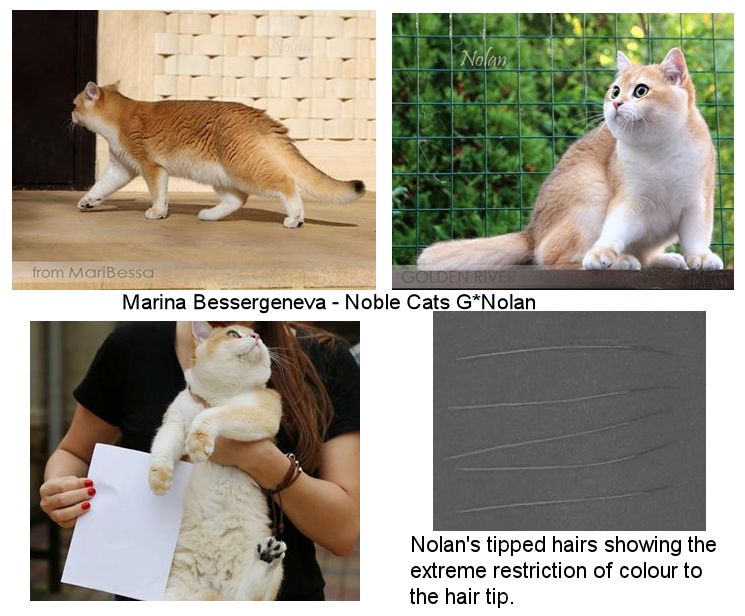
WIDE BAND: INVESTIGATING COPPER / FLAXEN GOLD / LIGHT GOLD PHENOTYPE IN BRITISH TIPPED SHORTHAIRS
This page is about the history and investigation of this phenotype. In 2022 it was identified as a CORIN gene mutation.
Copper = akita/urajiro = light gold = flaxen gold = British sunshine (there are multiple names for this mutation in British Shorthairs/Longhairs)
In the early 21st century a new type of “golden” appeared in Tipped and Shaded Golden (Golden Chinchilla and Golden Shell) British Shorthairs. It looked like an "ultra wide-band" effect where the colour was pushed so far to the tips of the hairs that the genetic colour (black, blue, chocolate etc) was barely discernible and the paler areas were a very extreme golden colour that was almost white. The term "copper" (now known as Flaxen Gold by WCF) was adopted by Linda Petersson Wahlqvist to describe Golden Shell cats with white toes, white undersides, golden colour with the dark tips (e.g. black or blue) restricted to the tail tip and an absence of dark nose-liner. These phenotype deviates from the standard for tipped cats but became widespread in Russia and in some German lines of British Golden Shorthairs. Breeders sought recognition for this colour as "Light Gold," but the term "Flaxen Gold" was preferred by WCF. The naming is not yet decided.
Although the true Copper/Flaxen Gold phenotype involves tipping/ticking, what do tabby-marked related cats look like? i.e. how does it affect non-ticked cats? It seems to turn the markings to gold and the only evidence of the black marking colour is seen at the tail tip and on the paw pads.

EMERGENCE OF COPPER/FLAXEN GOLD IN RUSSIA
Refer to Wide Band: History of the "New" Colours "Golden Copper" and "Golden Akita" in the British Breed
The new goldens (and related new silvers) British Shorthairs/Longhairs that appeared in Europe were not ny11 (tabby-based goldens), but were ny25 (ticked-based goldens) and attracted a lot of interest in Russia. In adulthood the ticked-based goldens and silvers had extremely uniform tipping with no hint of a tabby pattern. Breeders, particularly in Russia, continued to select the brightest gold chinchillas to breed with and the brightest, most orange, golden cats had pale toes and pale markings around the eyes as well as an ivory belly. This was known as "akita" or "urajiro" by Russian breeders and "copper" elsewhere. Some cats were pale yellowish gold with nearly-white toes. The bleached (or “excessive”) version was termed "flaxen gold" by WCF and the light gold (colour of set honey) is also called "British Sunshine" by some breeders but is not the same as the Siberian sunshine mutation. Fans of the colour saw it as a natural evolution of colour to create the perfect golden cat. (The older term "CORIN gold" was dropped as further CORIN mutations were identified).
From 1st March 2021, associations affiliated with WCF had to segregate the standard golden kittens from the copper/flaxen gold (extreme golden) kittens which have pale bellies and white feet. Different coding on the pedigree keeps the new colour separate from the original golden colour so breeders can decide whether or not to use a copper/flaxen gold cat in their golden programmes. Until "flaxen gold" (WCF term) is officially recognised with its own code, these cats can’t compete in the golden class against classic goldens.
VARIOUS THEORIES
Initial investigations, starting in 2016, were based on known mutations and on pedigree analysis. At the same time, DNA was collected for analysis from cats with the new phenotype. In the meantime, several theories were put forward based on known mutations and genes, some more plausible than others. Leslie Lyons of the Lyons Feline Genetics Laboratory has been researching silver and golden for a number of years without identifying a gene; the emergence of the flaxen gold and extreme chinchilla phenotypes may prove fresh impetus for research and new genetic variations for study.
Ultimately, detailed pedigree analysis revealed an autosomal recessive inheritance pattern for the “British recessive wideband” (wbBSH) gene. The earlier theories are still worth summarising.
Abitbol, M., Dargar, T. & Gache, V. (2022) Golden cats: A never-ending story!. Animal Genetics, 00, 1–4.
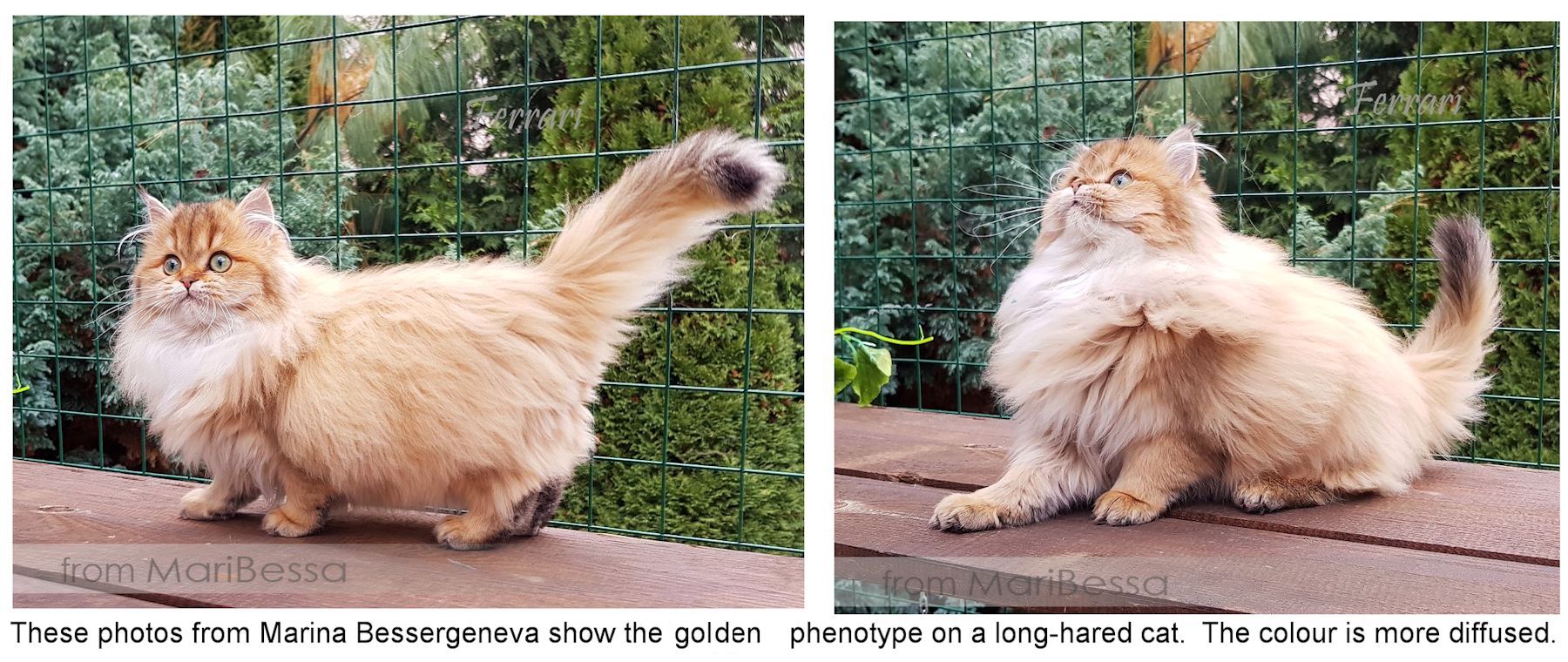
1. WIDEBAND POLYGENES?
Classic shaded and tipped (shell/chinchilla) are due to the dominant Inhibitor gene (silver) + Wide Band + Ticked Tabby. In silver cats the dominant Inhibitor is present. In golden cats, the dominant Inhibitor is absent. Although "Wb" was treated as a single dominant gene for simplicity, it might have been polygenes with an additive effect, or different genes in different breeds. In ticked tabby cats without silver, Wide Band restricts the pigment to the end of the hair leaving a pale golden band between the skin and the pigment. Through selective breeding, this effect has been maximised. The polygenes theory suggested Wb, Wb+ and Wb++ would account for cats with normal, intermediate and greater degrees of Wide Banding. Ultimately as single recessive gene was identified for the British Shorthair/Longhair copper/flaxen gold phenotype.
2. EXTENSION GENE?
Another possibility was a recessive mutation at the E (extension) locus, such as "amber" (seen in Norwegian Forest Cats). These reduce the amount of black and the effect ranges from no black (as (seen in chestnut horses) or residual black (as in amber cats) while not affecting the skin pigment. Amber cats are genetically black with a colour modifier that affects the deposition of pigment on the hair shaft; in non-agouti ambers the nose remains black and in agouti cats it remains pink. The Flaxen Gold cats with black paw-pads and tail-tips, but without black on the body, suggested a recessive E allele. While plausible, the gene identified for copper/flaxen gold in British Shorthair/Longhair was on the CORIN locus.
3. SERIES OF ALLELES AT ONE LOCUS?
Based on research into Siberian "Goldens" (Golden-Sib) there might be a series of alleles at one locus: non-golden >> golden >> copper/flaxen gold. In Siberians there appears to be a series Non-Golden-Sib/non-Sunshine >> Golden-Sib >> Sunshine caused by a CORIN gene mutation. While the gene identified for copper/flaxen gold in British Shorthair/Longhair was on the CORIN locus, it was a different mutation; the third CORIN mutation identified in domestic cats.
4. NEW DOMINANT MUTATION?
A further possibility was a new dominant mutation at the A (agouti) locus. In dogs, this creates the fawn/sable colour, often with black shading or tipping long the spine. Similar dominant A alleles occur in several mammal species. In domestic cats, agouti (ticked hairs) and non-agouti (self/solid colour) are well known. Could wideband be at the ticked locus? The extreme silver and the copper/flaxen gold phenotype are both associated with ns25 and ny25 (ticked tabbies). Could an unidentified mutation at the A locus cause a change in frequency and/or width of ticking, and showing up through selective breeding for colour? At least two other variations at the A locus occur in wild cat species. A mutation at the E locus or A locus would interact with any Wide Band gene(s) to further restrict colour on the hair shaft. Linechasing and pedigree analysis showed a recessive mode of inheritance.
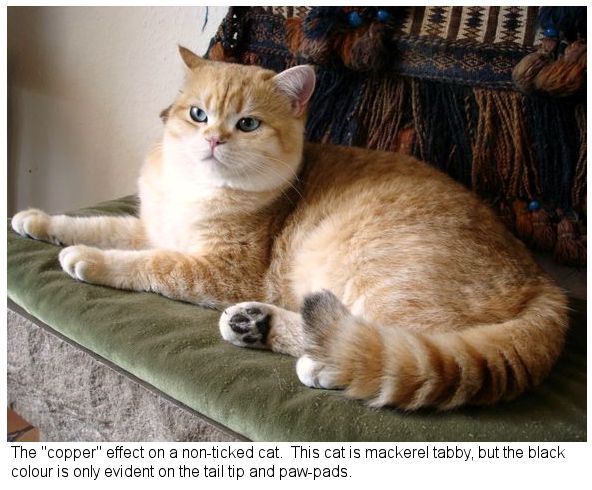
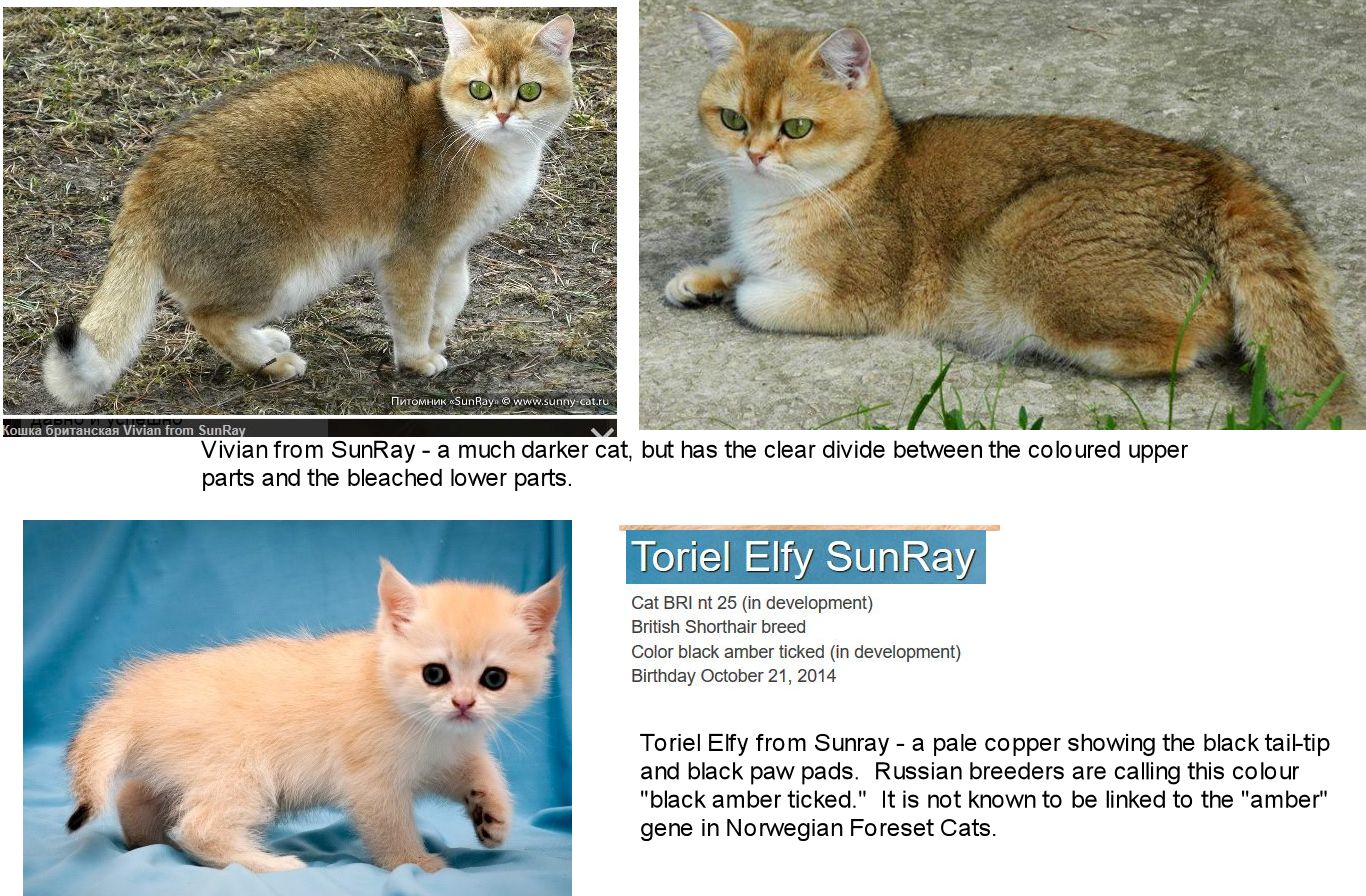
5. AN INDEPENDENT MODIFER?
The Copper/flaxen gold colour (the provisional symbol “cp” is used here) might be an independent recessive modifier gene affecting Wideband and “copper” phenotype cats might be i/i, Ti/-, Wb/-, cp/cp or i/i, Ti/-, Wb/Wb, cp/cp genotype (homozygous no silver, dominant wideband, ticked tabby, homozygous copper/flaxen gold modifier). With this theory, a cat with I/-, Ti/-, Wb/Wb, cp/cp genotype would be nearly white – and this is indeed the case with extreme chinchillas that are closely related to flaxen gold cats. Extreme silvers look almost white apart from their eye colour. However, not all tipped (chinchilla) cats are ticked tabby cats so the presence of “Ti” would not be necessary to get the flaxen gold phenotype.
6. CORIN GENE?
Xiao Xu, Ph.D., Associate Investigator (Laboratory of Genomic Diversity and Evolution, School of Life Sciences, Peking University, Beijing, China), identified a CORIN gene variant CORIN p.H587Y to be the wideband gene responsible for white and golden tigers, but not responsible in chinchilla cats. Stripeless (ghost-striped) white tigers and golden tigers visually resemble extreme chinchilla and golden cats which made CORIN a candidate gene for chinchilla and golden in cats. In deer mice, the Inihibtor gene (A locus) was found to cause the wideband effect. So far only two wideband genes have been identified in mammals – CORIN in tigers and Inhibitor in deer mice. Because golden is related to the number and width of bands on the hair shafts, another candidate is AGRP (agouti related protein). (Xu X, Dong GX, Schmidt-Küntzel A, et al. The genetics of tiger pelage color variations. Cell Res. 2017;27(7):954-957.)
7. DOMINANT WITH ADDITIVE EFFECT?
To date, textbook assume the golden colour in domestic cats to be a recessive trait. Could it be a dominant gene with additive effect i.e. one copy of the Wideband gene (Wb/-) gives golden, but 2 copies (Wb/Wb) gives a more extreme golden effect? The various expressions of golden could be due to different combinations of inhibitor, ticked and wideband. This is already an accepted theory by many cat breeders, based on pedigrees and visual observation, but there is not yet any scientific evidence for this.
Black ticked (n25) - i/i, Ti/-, -/-
Golden ticked (ny25) - i/i, Ti/-, Wb/-
Golden chinchilla (ny11/12) - i/i, Ti/-, Wb/Wb
Black silver (ns25) - I/-, Ti/-, -/-
Shaded silver (ns12) - I/-, Ti/-, Wb/-
Chinchilla silver (ns11) - I/-, Ti/-, Wb/Wb
Usually, a dominant effect is caused by a gene gain-of-function (increased activity of the gene), and a recessive effect is caused by a gene loss-of-function (decreased activity of the gene). If the Wideband gene is dominant then increased activity of the CORIN gene would reduce the pheomelanin (red) bands, not make them wider. However, if the I gene (A locus) has increased activity it could cause the wideband effect in cats the same way it causes wideband in deer mice.
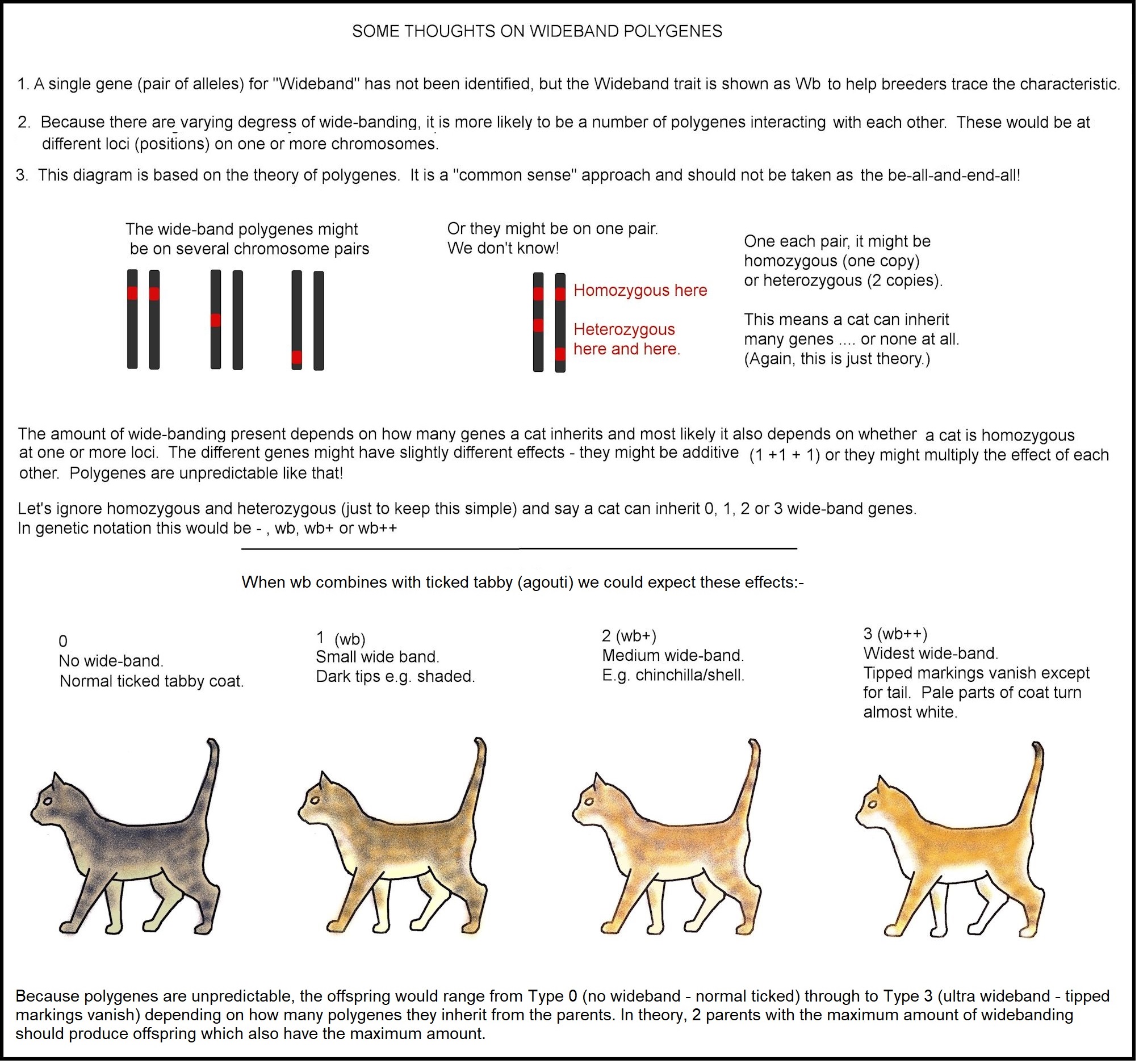
8. A CONNECTION TO CINNAMON AND CHOCOLATE?
Johanna Nordin (Sweden) investigated the copper/flaxen/light gold phenotype from another direction. Her first thought when she saw the red-white golden cats was the Abyssinian sorrel colour, which is cinnamon + ticked, and she started thinking that the cinnamon allele of the bl gene might have a role in the light gold cats. She discussed this with an experienced breeder of golden and silver British Shorthairs who has been breeding them for some decades. The breeder told her that the "light golds" are carriers of chocolate and that there might be some crossbreeding with Abyssinians in the light gold-lines but that was not the official standpoint.
Johanna then went on to check out the expression of the chocolate colour in Abyssinians (23b). Chocolate ticked Abyssinians resemble the red-white golden coats of light gold phenotype British cats (such as Sundust Macavity whose image can be found online), but had more white on the chin and toes. They also had the same black at the end of the tail tip. In Abyssinians the colour is described as “rich copper brown ticked with dark chocolate; Base Hair - Rich Apricot.” Were the light gold cats ticked chocolates with Wide band (and maybe other polygenes) and without inhibitor (golden ii = non silver)? This could explain why the light golds have more white on the chins, toes and undersides than the Abyssinians (which don’t have the wide band and other polygenes) and a lighter base colour. Side by side, there is a similarity, allowing for the brighter and more whited appearance of the light gold shorthairs.
If Polar Jenko carried sorrel/cinnamon, as suggested by Russian breeders of the "new golden" phenotype, it came from an Abyssinian ancestor 8 generation ago on his sire's side. Russian breeders saw it as a welcome and unexpected gift from imported Oaxaca and Wahrberg cats. If the light golds were tested and found to be chocolate and cinnamon, that would make them (in EMS terms) "chocolate golden tipped/ticked = by 11 (25)" or "cinnamon golden tipped/ticked = oy 11 (25)."
Eventually the chocolate/cinnamon colour was found to be a coincidence.
LINE CHASING
The appearance of copper/flaxen gold was investigated by tracing the family trees of cats that displayed it. There was no single mutation or common ancestor, but there was an interaction of mackerel tabby (ny25) with chinchilla (ny11) and possibly an accumulation of Wide band polygenes. As well as Flaxen Gold, there were extreme chinchillas where the dark tipping was reduced to almost nothing. Only the eye colour and paw-pad colour showed that these were Chinchilla cats and not solid white cats. This shows that “Ultra Wide Band” affected cats with and without silver. Cats without silver and without Wide Band are cool-toned ticked tabbies. Because ticked tabby is on a different locus from classic/mackerel/spotted tabby, those patterns can sometimes breakthrough the ticked pattern to some degree.
The following colour-coded family trees should be opened in new windows so they can be read at full size! They show the relationship between ny11 and ny25. They don't answer the question of what gene(s) cause the copper/flaxen gold phenotype. They are aimed at showing common ancestors of copper/flaxen gold cats and different combinations that have led to the flaxen gold phenotype.
Then came the question of how many lines traced to a Persian Shaded Golden called Esteban von Aemstelhove (or van Aemstelhove). Mated to Marvellous Golden Desiree, he produced Goldstern de Broekloni who was a prolific stud used in Silver and Golden British Shorthairs. Esteban von Aemstelhove was noted for his very warm golden coat and it seems likely he had a very good Wide Band trait that was passed down in his descendants. His great-great grandson was Marvellous Gold Radetzky, another prolific stud who appears behind several flaxen gold British Shorthairs. According to the databases, Esteban von Aemstelhove's other offspring remained in the Persian/Exotic gene pool.
This can be traced even further back to another common ancestor called Polar Jenko. There is an Abyssinian a long way behind Angelika Niesel’s Polar Jenko, born 1988. Ancestors included Oriental cats a Russian Blue and registered pedigree unknown cats (possibly with Aby blood?). There is almost no information on his “van Wier en Gouwe” ancestors except that Amor van Wier en Gouwe’s parents are Chinchillas. There are many other cats that are untraceable. Also in that pedigree we find Danilo of Great Yarmouth (PER, cannot be traced) bred to Aminda de Malpertius (Russian Blue) and the offspring registered as British Shorthair. Polar Jenko descends from the Dutch Potentillas line. Also back then the silver SH cat was being developed. Polar Jenko was very valuable for breeding silver British cats, as he represented of a completely different line, and was very compact and massive. He also had a valuable set of genes: he carried the Colourpoint gene and apparently brought the sorrel (cinnamon) gene to golden cats. Jenko was in the possession of Mrs. Ursula Muller of vom Wahrberg cattery, since Abdullah, another Oaxaca – Anais stud, did not get along with Polar Jenko. If Polar Jenko carried sorrel/cinnamon it came from an ancestor 8 generation ago on his sire's side. Russian breeders saw it as a welcome and unexpected gift from imported Oaxaca and Wahrberg cats.
According to a breeder, the cat Viola vom Wahrberg (who links many pedigrees to Polar Jenko) was not actually Jenko's daughter. Jenko did not carry dilution. The breeder had another young male at the time named Marvellous Rembrandt. Golden Sahra vom Wahrburg had 6 kittens, 3 were blue-golden and 3 were black-golden (grey colour). It could be seen that the 3 blue-goldens were from Marvellous Rembrandt, a confirmed dilute carrier. Jenko never gave dilution but point cats. Jenko never gave reddish (copper/flaxen gold) coloured kittens. Over several generations the colour got warmer. The first copper/flaxen gold colour cat in many opinions was Marvellous Radetzky.
So now to trace Marvellous Golden Desiree and Marvellous Golden Radetzky (highlighted in previous trees) back to Persians, American Shorthairs and Scottish Fold Shorthairs. Rather naughtily, the American Shorthairs are shown on some databases as BRI (British) which hides the ancestry of some of the cats. I've highlighted the outcrosses and noted the breeds, and also highlighted a couple of influential cats. Behind some of the copper/flaxen gold lines are ny12 Persians (I haven't traced further back). It's obvious that these outcrosses will result in British Longhairs further down the line.
Below shows Persian and Exotic Shorthair influences. This moves the British Shorthair even further away from its original type and closer to the Persian/Exotic type as well as affecting the silver and gold colours.
Now to look at some of the other cats that have sneaked into the British Shorthair gene pool (as a request from breeders wanting to avoid those influences). Nirvani Du Mouli D'Amelghem is descended from Scottish Fold straight-eared variants. Sunnyland lines and Goldenen Winkel lines trace back to Selkirk Rex variants. British Shorthair is an allowable outcross for Selkirk Rex, but the straight-haired variants don't usually go into British Shorthair lines. You can also see that Andy vom Wahrberg was a prolific stud who has also contributed to Selkirk Rex lines.
Marina Bessergeneva has a copper/flaxen gold phenotype cat, Noble Cats G*Nolan. His family tree is also shown. The photos show how pale some areas are and the extremeness of the restriction of colour to the very end of the hair. The fur is definitely tipped and not visibly ticked, but it’s possible all ticking has been pushed to very end of the hair. A search online finds that some breeders of the copper/flaxen gold phenotype are also breeding ticked tabby British Shorthairs. Now that ticked tabby is reintroduced into the British Shorthair, allowable crosses could add this gene to tipped cats. It is known that one breeder crossed British Shorthair and Abyssinian to get a warm n25. A judge in Turkey suggested that some breeders may have used the Abyssinian previously in order to reduce ghost markings and get a warmer colour. Discussions on this have been found in Russian forums, but there is no direct evidence.